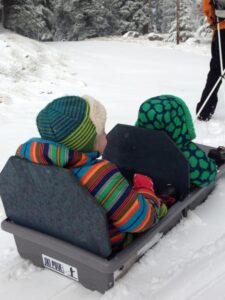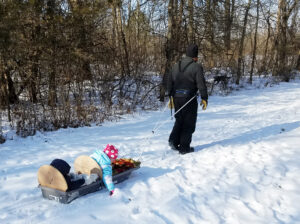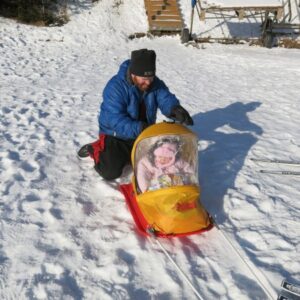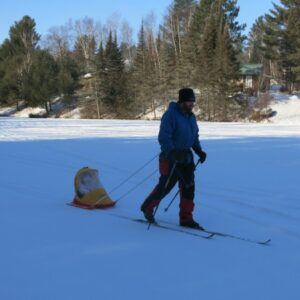How do you use a pulk with children?
We are often asked if our pulks work well for pulling kids or which sled we recommend using with children. We’ve compiled some options for pulling your child while you ski or snowshoe.
Pulling your kids behind you in a sled isn’t a new invention. But, new gear and creative people have made pulling your kids so much easier! Now you don’t have to just pull your child with a rope while they bang into the backs of your legs on any inclines – you can pull them in a pulk! You’ll find several commercial pulk companies that manufacture systems specifically for kids – and they are slick! The Chariot Carrier looks amazing and we’ve heard great things about it. There’s also the Thule system and probably others we’re not yet aware of. But, if those sleds seem a little out of your price range, you can also make your own pulk to pull your child. Here are a few ideas:
1. Purchase any child’s sled (or maybe you already have one) and connect our poles and harness to it so you can ski or snowshoe while having control over the little ones being towed behind. While we know many people who have pulled kids in a Paris based pulk with a Crazy Creek type chair, we do not recommend pulling children without a secure harness system and a backrest that can function as a roll bar. It is difficult to do this in the Paris sled.
2. Another option is to use our Snowclipper pulk system. There are two slots in the Snowclipper which makes adding backrests or dividers very easy. While we do not provide the backrests or dividers, you can easily use cardboard to create a template and cut them out of 1/2″ plywood.
Once you have the backrest, you can secure it to the sled and add harness configurations depending on the age of the child. With such precious cargo, be sure to ski well within your limits of controlling the sled.
Check out this video describing the Snowclipper backrests for pulling kids:
We’ve tried out a couple of other sleds that have worked well for our young daughter (15 months at the time of this article) that come with built in harness systems.
3. The first sled we tried was the Paris Snowflake (from the same company who makes the popular Paris Expedition sled). We liked it because it had a shield to keep her warm and cozy and it had straps to keep her upright (since at 8 months she wasn’t the most stable sitter while riding in a sled). But, there were also some drawbacks. The shield wasn’t very easy to install and even though the sled fit her well at 8 months, our 2 year old niece was almost too big for it – so it wasn’t going to last us long.
4. Then we found the Pelican and tried their sled. You can find the Pelican Baby Sled Deluxe online at Amazon by following this link. This sled is bigger than the Paris Snowflake and we prefer it since it will last us longer and was more convenient to assemble. It has a shield to keep her warm and toasty (even in -18F wind chills! Oh Minnesota winter ;) and has a strap to secure her (although that is one drawback – the Snowflake was better at keeping her secure since it had over-the-shoulder straps instead of just a waist strap) but it does the trick. One other thing we read might be a drawback is that the shield zips in the back so you have to put them in and take them out over the seat. But, we found that you can just push the shield forward and get them in and out just fine.
On both of these sleds we were able to attach our pole and harness combo to provide good control while pulling our daughter.




